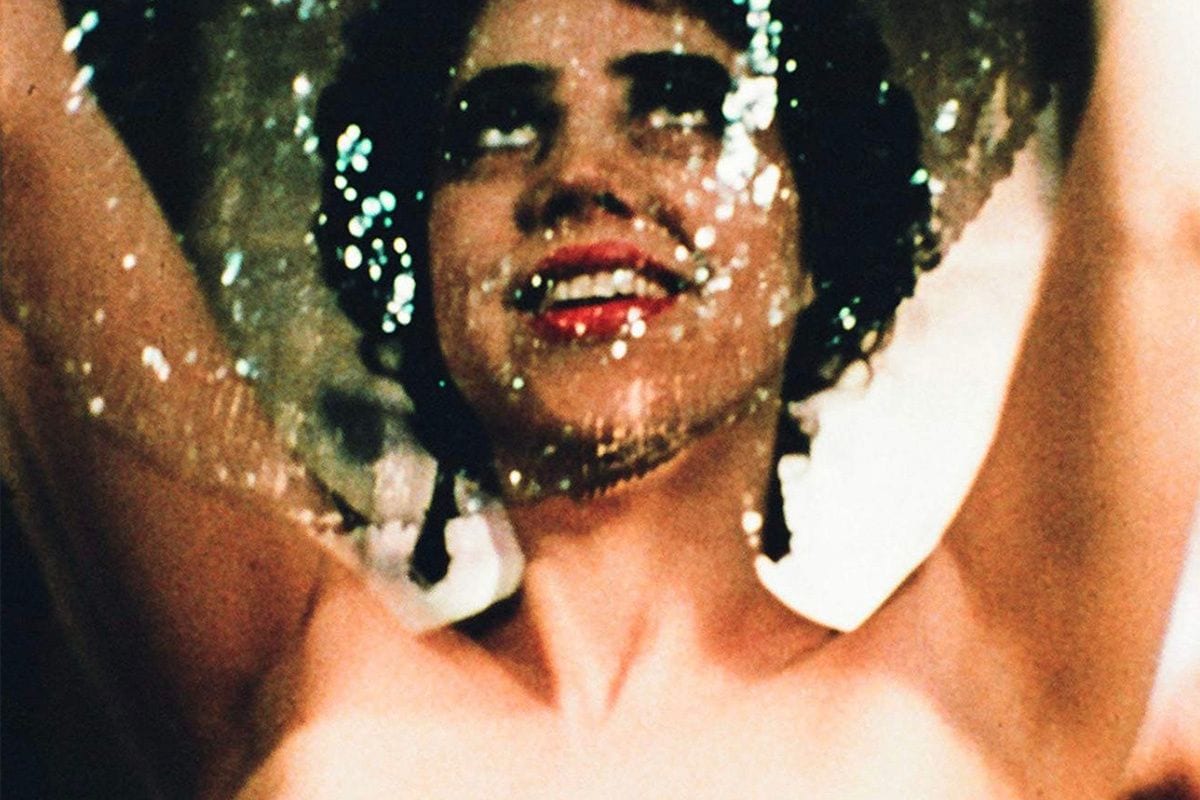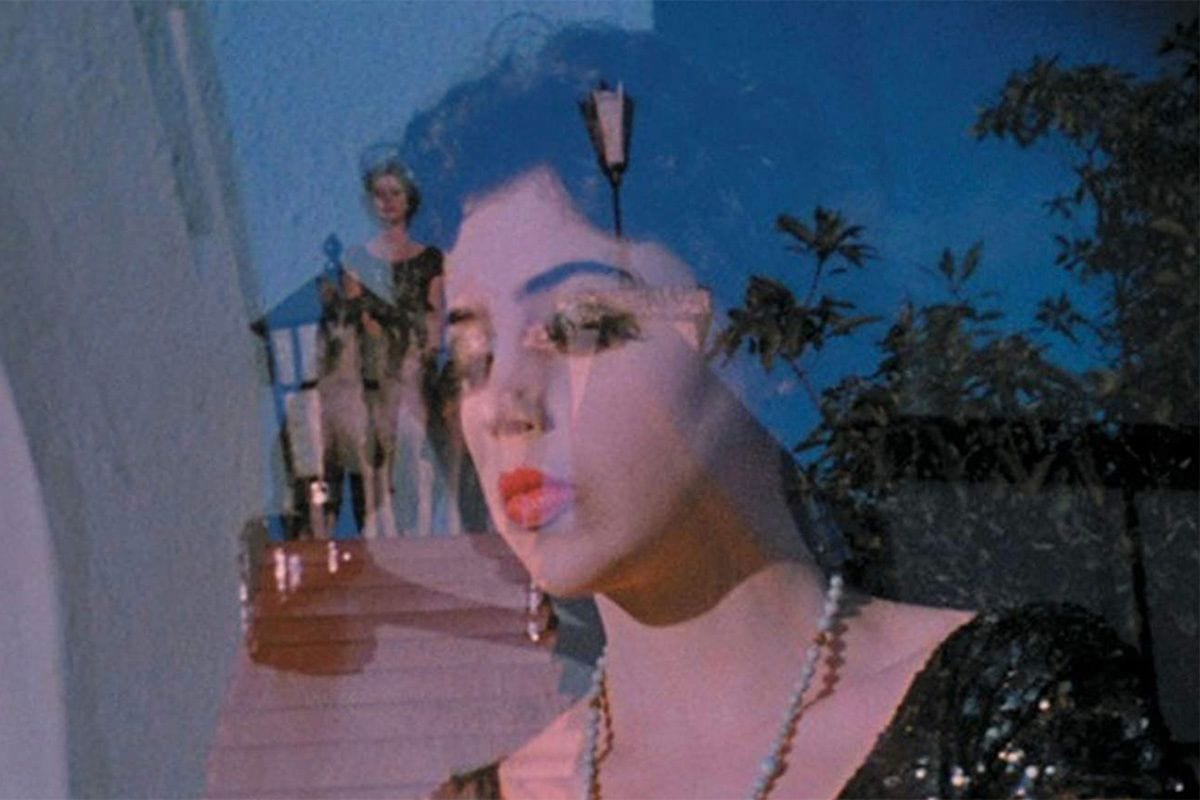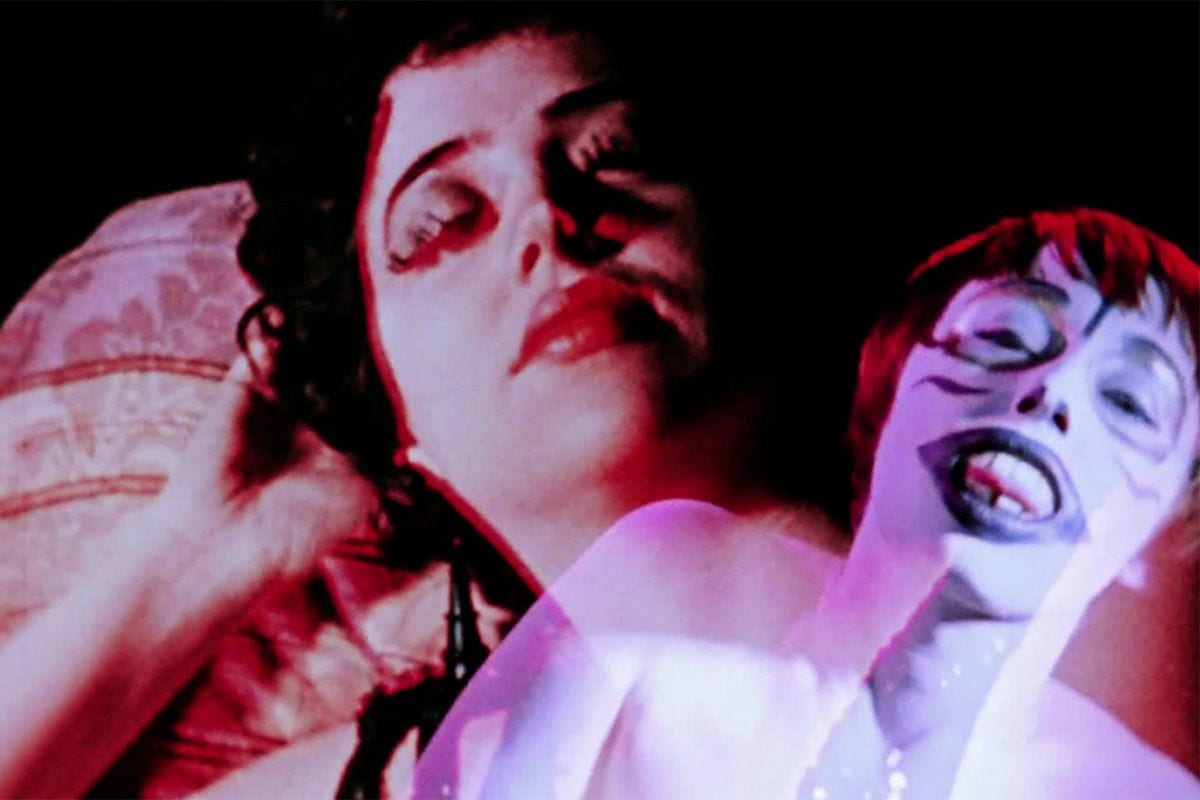Over a black screen, in garish pink font outlined by vivid turquoise, the words “a film by ANGER” come into view. Not “a film by KENNETH ANGER”… no, he has chosen to omit his first name for a far more ostentatious, and multilayered, mononym. It’s an unconventional choice, a self-assignment of notoriety, yet not a single soul in a mainstream circle would recognize it…at least not in the way they would recognize “a film by LANG” or “a film by CURTIZ”. And yet, with its bold and brightly colored visage, it is almost as if Anger expects you to know who he is, to blindly and readily accept this sense of self-attributed stardom, while simultaneously recognizing himself that most mainstream audiences would not, in fact, have knowledge of who he is, or his avant-gardism, and as a result, are “out of the loop”.
It is this kind of absurdism—this fascination with fame and glamour, the stylistic presentation of an artist’s name akin to the presentation of a venerated show-business legend (despite being the farthest thing from one at that point in time), the full and self-reflexive embrace of artifice—that comes to define Puce Moment (1949), Anger’s overlooked touchstone of the early avant-garde cinema movement. It is a rare masterwork that, before Susan Sontag even uttered the term “camp” in her now benchmark 1964 essay, “Notes on Camp” (Partisan Review, 1964) set the bar for just exactly what that sort of aesthetic would come to embody.
What exactly is “camp?” It has been the subject of extensive discourse with this year’s Met Gala, which saw myriad celebrity personalities line the red carpet in outfits that ranged from old-school glamorous to utterly outrageous. Defined as “ostentatious, exaggerated, affected, theatrical”, (“What Does It Mean to Be Camp?” Joobin Bekhrad, BBC, 7 May 2019) camp is best known nowadays as the defining style of such films as What Ever Happened to Baby Jane? (1962), Valley of the Dolls (1967), Rocky Horror Picture Show (1975), and Mommie Dearest (1981), and such musical artists as Cher and Björk. By conventional standards, camp is nonsensical, a grotesque exaggeration and even bastardization of common norms and tastes, a fascination with artifice and artistic extremism. It takes the man-made constructs of our world—gender roles, fashion, popular culture, beauty, social normativism—and distorts, even radicalizes, them.
Often times, camp happens by accident. Certainly in the case like Valley of the Dolls, its producers’ attempts at crafting a compelling melodrama were transmuted by histrionic writing and over-the-top performances, turning the film into an accidental comedy better remembered for its glitzy outfits, bold color schemes, and outrageous hairstyles circa 1967 than its meditation on drug addiction. Yet, critics and audiences have found in Valley of the Doll‘s unintentional campiness new and more vital,fruits over a half-century later; its overt glamorization, and even fetishization, of said ’60s-era aesthetics have since offered a revelatory window into gender politics, human sexuality, queer visibility, and the science of fame unlike any other film or text that came before it.

Yvonne Marquis (IMDB)
This kitschy theatricality, mixed with a (knowing or unknowing) rejection of dominant cultural standards (knowing in the case of a film like John Waters‘ 1972 film, Pink Flamingos, or unknowing in instances like Valley of the Dolls), has made camp a widely embraced aesthetic in the queer community who have found in its gaudy and seditious nature an extravagant, parodical haven that’s leagues away from the oppressions of a cis-heteronormative world. In the documentary Gotta Get off This Merry-Go-Round: Sex, Dolls, And Show-tunes (2006), gay-identifying entertainment columnist Ted Casablanca puts it best: “It’s the bigger than life stuff that we often tend to go for, because our ordinary lives are often so, if we let heterosexual society get away with it, painful…unhappy. So what do we do? We’re gonna escape into the smuttiest, tackiest, biggest, over-the-top, bejeweled stuff we can find” (see this clip of Gotta Get off This Merry Go Round: Sex, Dolls & Showtunes on YouTube).
It comes as no surprise, then, that Anger dreamt up a subversive masterpiece like Puce Moment in the first place, being an openly gay man whose game-changing filmography has come to boast the same kind of experimentations as the work of Andy Warhol and John Waters—only decades earlier.
In the postwar years, Anger cemented himself as one of the leading avant-garde cineastes of his time, along with revolutionaries like Maya Deren, by demolishing the conventional standards of cinema language as dictated by major studios and engaging with film as a more tactile, fine art form. Whereas Deren imbued her work with a surreal psychosis drawn from choreographic traditions and the science of dreams (1943’s Meshes of the Afternoon and 1944’s At Land being the most potent demonstrations), Anger imbued his work with a surreal psychosis drawn from queer realities. Here, then, the distinction between Deren and Anger becomes clear: while both created art that was equal parts beautiful and mutinous, Anger’s, in a homophobic postwar America, was illegal. It comes as no shock, then, that his first major work, Fireworks (1947), landed him in a contentious court case for exhibiting to American movie houses what is essentially a homoerotic wet dream.
Puce Moment, which came two years later, emerges as a different kind of dream. As in Fireworks, you won’t find handsome sailors or the sparks of Roman candles posing as metaphoric ejaculate. What you will find, however, are more covert allusions to the social and aesthetic realities of Anger’s existence and art, the same sort of illuminating material in later Hollywood films like Valley of the Dolls and Rocky Horror Picture Show (and even in many of Anger’s later films, notably 1966’s Kustom Kar Kommandos, another candy-coated short oozing camp).

(IMDB)
The events of the six-minute film are rather mundane on paper: a beautiful young woman dresses in a flapper gown and applies makeup at her vanity before a magical chaise lounge carries her out onto her back patio, upon which she decides to take her Borzois for a walk. But Anger is not concerned with narrative logic. Rather, his visual and formative distortions of the film’s “plot” make Puce Moment perhaps the earliest cinematic artwork to adopt the camp tradition, and unlike any other (certainly mainstream) motion picture of the 1940s, it is self-aware in its appreciation and understanding of glamour, artifice, exaggeration, and of the power of sexuality and materialism. It inherently comprehends, and resultantly subverts, the mechanism of the male, and even female, gaze on such people and such accessories.
The first indication of Anger’s campy distortion is the prologue to his plot. Inexplicably, a series of flapper dresses are danced (by an unseen puppeteer) in front of the screen, before fudging the lens to reveal subsequent dresses on the rack in perpetuity. Anger is vomiting glamour into our face, objectifying objects, sexualizing what cannot, in a vacuum, be sexualized: silk, velvet, cotton, glitter. Our world is tactile and corporeal, and it is overwhelming. But we cannot get enough of it.
Then, we discover, Anger’s vision of human behavior has morphed into a dizzying, enigmatic mechanism. For the simple action of slipping a dress over her head, endless dissolving frames—many of which only feature the garb’s glittery fabric saturating the screen in a gaudy tremor—turn a singular movement into an overblown material odyssey. Thus, what is material becomes personified, and what is already personified becomes material.
Amid the flashes of glitter, we catch the first glimpses of our protagonist’s face. She is beautiful, in a way so lavish and so extreme it registers as uncanny. Like marks on an oil pastel drawing, her mile-long lashes and fuchsia lips feel tangible, as though Anger has lit a match and melted his celluloid into a waxy, textural froth. Later, she twitches robotically across a multi-patterned carpet, a “tacky” (as deemed by conventional tastes) hybrid of florals and geometrics, to a vanity covered in myriad perfume bottles that look less like commercial liquid containers and more like glass origami figures.

(IMDB)
For the first time, now, we see our protagonist in full form. The detail of her face is out of focus now, but she stands adjacent to her mirror, a synthetic madonna spritzing scents out of an oversized emerald orb, the almost antiquated purity of her vanity’s ivory frame clashing against her scintillating dress and the red and green drapes that cascade behind her. But it is that very clash—of colors, of fabrics, of sentiments—that elicits the most joy in Anger and, if one is willing, the viewer. It is the kind of optical engagement, equal parts alluring and agonizing, that could never have flown in a major Hollywood feature. In the world of camp, it marks an unprecedented kind of aesthetic liberation.
There is a sexual liberation too. As our protagonist splays herself across a chaise lounge covered in purple-and-cream stripes—the same chaise lounge that begins inexplicably moving on its own, eventually bringing her outside to her sun-soaked patio—she at first registers as an object of heterosexual male desire. But Anger’s infusion of the camp sensibility (via atypical editing, a frenetic frame rate, and a candy-coated color palette where neutrals simply cannot exist, where overstimulation manifests in hues and near-tangible textures) drains the film of the “conventional” or “normative” ground upon which the male gaze, like in so many polished studio films of the era, can fully flourish.
Anger’s direction adulterates and outsmarts mainstream filmmaking conventions, alienating viewers unwilling to think beyond immediate visual semiotics as dictated by hegemonic standards…or, in other words, viewers unable to embrace everything camp is and stands for. Our protagonist, then, becomes the center of that technical and aesthetic alienation—no longer an object of male sexual desire, but of complete autonomy over her sexuality and performance of gender, possessing the same kind of confidence and awareness as Anger’s own self-aware exhibition of consumer objects and material pleasures throughout. Our female protagonist is, quite literally, driven out of the oppressive boudoir and into the light.
It would be injudicious to defend Puce Moment‘s camp status without discussing a significant alteration it underwent more than 20 years after its initial incarnation, further attesting to its applicability, and durability, in the culture. In 1970, Anger daringly replaced its original operatic soundtrack with a psychedelic folk rock piece by Jonathan Halper. During the film’s opening dress sequence, a nightmarish synthesizer comes to outshine the visuals in garishness, before dissolving into a rapid, yet despondent guitar as we first meet our protagonist. Layered in with Halper’s vocals, whose lugubrious tenor against ambitious words bespeaks a kind of parallel-universe Lou Reed (“So I’ve decided to leave my old life behind, I don’t need it anymore…I’m gonna learn to climb the wind”), it emerges as an unexpected countercultural statement that both comforts and displaces, enthralls and haunts.
On first watch, the combination makes for a jarring juxtaposition, eyes immersed in one context, and ears another. Adding increased bewilderment is an abrupt change in song as our main character stands before her vanity in full form, a transformation from hellish disconsolance to a steadier, more ethereal tone poem, with the recurring lyrics: “I am a hermit”. By conventional standards of narrative and style, the glamour-laden visuals set against psychedelic ’60s beats registers as a match made in hell, a directorial choice steeped in lunacy, discordance, even poor taste. But by the film’s end, at which point Anger has enlightened and radicalized our “traditional” viewing perspectives, we see exactly how harmoniously the two work together. The initial exaggeration of fashion, makeup, and consumer products melts into our hero splayed comfortably, and confidently, on her chaise, “hermitted” from reality, her own agent. First she aims to “climb the wind”…and then realizes just how much she doesn’t need to.
With the latter-day reappraisal of works like Valley of the Dolls and Pink Flamingos, and recognition of the eye-opening insights they provide, camp as an adjective and an aesthetic has transitioned, over the last half-century, from derogatory to laudatory, as proven by this year’s Met Gala, which thrust the term into the legions of celebrated mainstream discourse like never before. No longer a “genre” to merely laugh at or ogle, with a profound impact on popular culture and its eradication of the faux barriers separating “high” and “low” art (as we find increased value in its unapologetic and self-satirical nature with the ability to transcend barometers of “taste”), camp has become something to loudly and proudly revere.
For it, we can thank a filmmaker like Kenneth Anger, and a work like Puce Moment. In it, he has taken a Technicolor-soaked Sirkian melodrama, dissected, scattered, and reappropriated it. He has taken propaganda items like Constance Bennett’s 1937 “Daily Beauty Rituals: Photographed in Cinecolor!” (see here on YouTube) and tipped them on their head. He has indicted and subsequently repurposed the too-often toxic, machismo-laden motivations of high-brow fashion plates, pin-up posters, and runway culture. He has blazed the trail for Barbara Parkins’ wonderfully outrageous “Gillian Girl”, (see here on YouTube) and made kinship with Lady Gaga’s gold lashes and voluminous pink dress of the 2019 Met Gala red carpet…70 years prior.
Kenneth Anger was making camp before it was ever a fad. He was creating a glitzy, gaudy, absurd, subversive, queer, proto-feminist space at a time when such a space was damning…when there was no space at all.
- The 100 Essential Directors Part 1: Chantal Akerman - Bernardo ...
- Looking Back at the Avant Garde - PopMatters
- Sleeping with Strangers: More Prurient Than Its Hollywood Subjects ...
- Part 2: The Changing Face of Filmmaking - PopMatters
- Looking Back at Anger, or, We Always Have Paris - PopMatters
- Low Budget Hell: John Waters' Female Trouble and Cry Baby ...
- John Waters and the Demented Delights of the Demi-Monde ...
- The Dialectic of the Freak: On John Waters' 'Female Trouble ...
- Carsick by John Waters (book review) - PopMatters
- Love and Frogs: An Interview with John Waters - PopMatters
- Camp TV by Quinlan Miller (book review) - PopMatters
- Camp, Satire, and Serious Artistry in Carnival Krewsing - PopMatters
- Reborn: Journals and Notebooks, 1947-1964 by Susan Sontag ...
- So It's About Time I Asked, Who Is Susan Sontag? - PopMatters


![Call for Papers: All Things Reconsidered [MUSIC] May-August 2024](https://www.popmatters.com/wp-content/uploads/2024/04/all-things-reconsidered-call-music-may-2024-720x380.jpg)



